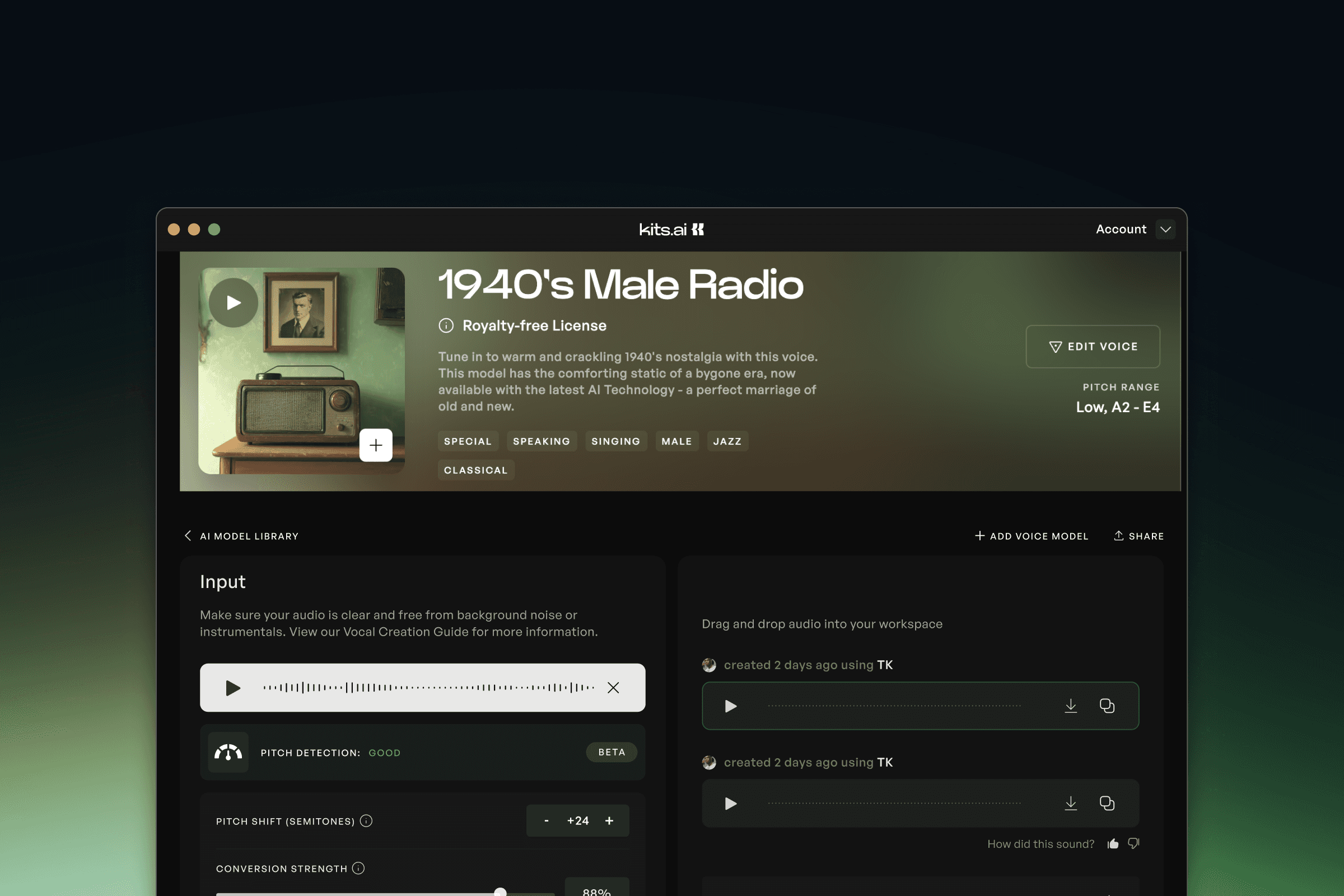1940년대 라디오 목소리의 매력: 나의 새로운 음성 모델에 대한 영감
작성자
게시됨
2024년 10월 30일
1940년대의 소리에는 시대를 초월한 무언가가 있습니다. 그 갈라진 듯하고 약간 muffled한 오디오는 즉시 가족들이 라디오 주위에 모여 뉴스, 드라마, 음악으로 가득한 방송을 듣던 그 시대로 여러분을 데려다 줍니다. 그 unmistakable한 따뜻함은 독특한 AM 라디오 품질과 결합되어 편안함과 강력함을 동시에 느끼게 하는 향수를 만들어냅니다. 이 signature한 소리는 저에게 새로운 목소리 모델을 만들도록 영감을 주었고, 그 시대의 본질을 포착하여 현대 제작에 접근할 수 있게 만들었습니다.
그렇다면 1940년대의 목소리가 그 독특한 개성을 지니게 된 비결은 무엇일까요? 한 번 정리해 보죠:
중간 주파수 중심의 음색
1940년대 방송을 들어본 적이 있다면, 그 시대의 목소리가 중간 주파수에 정확히 위치한다는 것을 알게 될 것입니다. 그 시대의 녹음 및 재생 장비는 자연스럽게 이 주파수 범위를 강조하여 따뜻하고 직접적인 음성을 만들어냈습니다. 오늘날의 녹음은 고음과 저음을 모두 강조하지만, 그 당시의 목소리는 저음의 rumble이나 고주파의 sparkle가 없었습니다–그저 집중된 존재감이 주목을 받았습니다. 이 플레이리스트를 YouTube에서 확인해 보세요. 우리는 매끄럽고 수정된 고음질의 소리에 익숙하지만, 이 소리는 매력이 있으며, 저의 목표는 이 목소리 모델로 그것을 재현하는 것입니다.

테이프 포화도와 78 RPM 아세테이트 디스크의 따뜻함
1940년대는 녹음 기술의 변화가 있었던 시기입니다. 아날로그 테이프 이전에, 78 RPM 아세테이트 디스크가 주요 녹음 매체였습니다. 1940년대 후반에 아날로그 테이프가 나타나면서 따뜻함과 하모닉 풍부함을 주는 미세한 포화가 도입되었습니다. 이 약간의 왜곡은 목소리에 아늑하고 경험이 있는 느낌을 주어, 귀를 위한 담요와 같은 역할을 했습니다. 테이프 포화도에 대한 추가 정보를 원하신다면, 이 비디오가 매우 잘 설명해 주고 있습니다.
저의 새로운 AI 목소리 모델에 관해서는, 저는 그 포화로 인해 신경 써서 질감을 조정했습니다. 그것이 존재하긴 하지만 압도적이지 않도록 했습니다. 여러분은 그 빈티지한 따뜻함을 느낄 수 있을 것이고, 현대적 믹스에서 버터처럼 잘 어울릴 것입니다.
좁은 주파수 범위
그 당시에는 라디오에 제약이 있었습니다–AM 라디오 방송국은 우리가 지금 익숙한 것보다 훨씬 좁은 주파수 범위에서 방송했습니다. 이 제약은 오늘날의 녹음처럼 "가득"하거나 "넓"지 않은 목소리를 만들어내는 결과를 초래했습니다. 대신, 그것은 더 집중된 초점을 가졌고, 종종 친밀감의 인상을 주었습니다. 그 제약은 그 시대의 정의적 특징이 되었고, 저는 저의 새로운 목소리 모델이 이것을 반영하여 녹음에 가까움과 개성을 가져오길 원했습니다.
주파수 범위를 식별할 수 있는 능력은 믹싱에 있어 매우 유용합니다. SoundGym와 같은 도구가 귀를 훈련하여 이러한 범위를 식별할 수 있도록 도와주며, 믹스의 문제를 쉽게 해결할 수 있는 능력을 제공합니다.
노이즈 요소
오래된 라디오 방송의 클래식한 hiss나 배경 crackle–사실, 그것은 매력의 일부입니다. 약간 더러운 거칠은 품질은 결함이 아니라 개성을 더하는 특징입니다. 1942년의 이 예제를 들어보세요. 이제 저는 제 모델에 정적을 잔뜩 담아두었다고는 하지 않지만, 그러한 미세한 불완전성에서 나오는 질감을 흉내 내도록 설계했습니다. 그래서 그 독특한 빈티지 느낌을 진정성 있게 전달하면서도 선명함을 해치지 않습니다.

템포와 전달
1940년대 라디오 목소리에는 이제 듣기 힘든 리듬이 있었습니다. 그것이 기술이든 방송 방식이든, 목소리에는 중대함과 권위가 있었습니다. 전달 방식이 독특하고 의도적이었습니다. 이 모델을 설계하면서 저는 그 자연스러운 흐름과 템포를 포착하고자 했습니다. 저는 남성 전통 팝 데이터셋을 사용하여 모델을 구축했습니다. 가수의 스타일은 그 지나간 시대의 전달 방식을 반영합니다.
여기서 제 전후를 확인해 보세요:
오늘날의 중요성
우리는 모든 뉘앙스가 깨끗한 세부 사항으로 녹음되고 들리는 시대에 살고 있습니다. 하지만 그 오래된 녹음에는 특정한 마법이 있습니다–오늘날의 초정밀 제작에서 종종 잃어버리는 인간적인 품질입니다. 이 목소리 모델은 그 시대를 초월한 사운드에 경의를 표하고 현대 제작자들에게 유용한 무언가를 만드는 방식이었습니다. 영화 음악을 작곡하든 트랙에 빈티지한 매력을 더하고 싶든, 이 1940년대 남성 라디오 모델은 그 unmistakable한 개성을 생명력 있게 표현합니다.
클래식 방송의 모든 매력을 갖추고 있지만, 현대 AI 도구의 다재다능함도 지니고 있습니다. 이것은 향수가 혁신과 만나는 시대 간의 다리와 같습니다. Kits.AI 를 통해 스스로 경험해 보고, 이 목소리 모델이 여러분의 제작물에 독특한 개성을 어떻게 더할 수 있는지 탐색해 보세요!
-SK
샘 케어니 는 콜로라도 에버그린에 기반을 둔 프로듀서, 작곡가 및 사운드 디자이너입니다.

